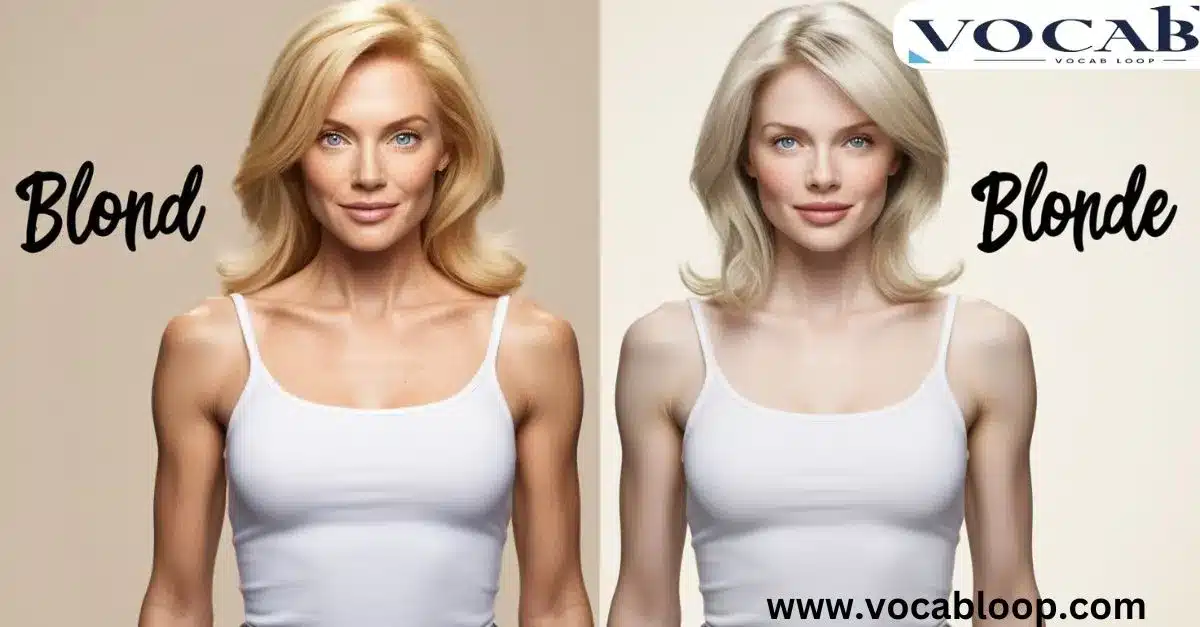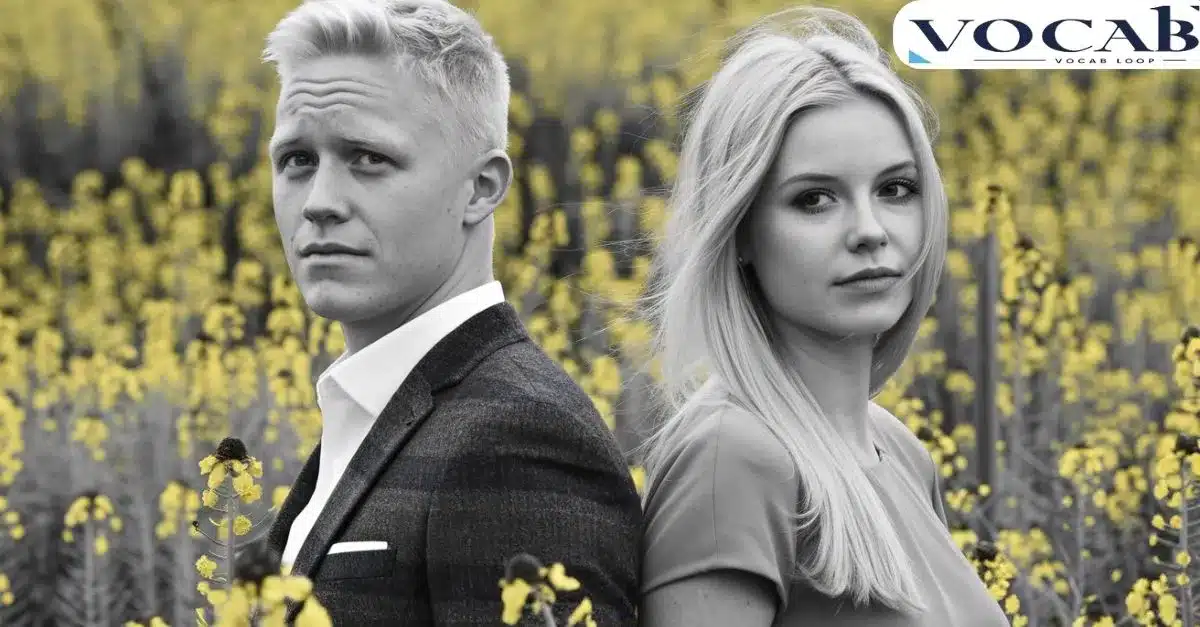Ever wondered whether you should write “blond” vs “blonde”. You’ve likely seen both versions used to describe light hair color, but they aren’t always interchangeable.
This guide will explain the nuanced differences, covering gender distinctions, regional spelling preferences, pronunciation, and historical context. By the end, you’ll know exactly when and how to use each form correctly.
Is “Blonde” or “Blond” Correct?
Both “blonde” and “blond” are correct, but their usage varies based on gender, geography, and grammatical function. The distinction originates from French, where adjectives change spelling depending on the gender of the noun they describe. English borrowed both forms but didn’t adopt this gender distinction consistently across all regions.
American English speakers often use “blond” as a gender-neutral term for all people with light hair, while British English speakers tend to retain the original French rules, using “blonde” for women and “blond” for men. This can lead to some confusion, but context usually clarifies which form to use.
What’s the Difference Between “Blond” and “Blonde”?

The primary difference lies in gender and traditional grammatical usage. Traditionally, people use “blonde” for women and “blond” for men. This distinction is not as rigid as it once was, especially in American English, where “blond” is widely used as a gender-neutral term for people of all genders.
For example:
- The blonde actress received an award.
- The blond surfer had sun-bleached hair.
Though subtle, these differences reflect how language evolves. Some publications prefer consistency and use only “blond” to avoid confusion, while others adhere to the traditional gendered spellings.
Understanding the Definitions and Usage
Now we will discuss the difference.
Blonde: Definition & Usage

- Blonde describes light-colored hair in a feminine context.
- It is used as both an adjective and a noun, though it appears more frequently as an adjective.
Example as an adjective:
- She has naturally blonde hair that shines in the sun.
Example as a noun:
- The blonde at the party had a captivating smile.
Blond: Definition & Usage

- Blond is typically used for males with pale hair but can also serve as a gender-neutral term.
Example as an adjective:
- He had short blond hair that lightened in the summer.
Example as a noun:
- The blond stood out in the crowd.
Using “blond” in gender-neutral contexts helps modern writing stay more inclusive. For instance, publications in the U.S. often use “blond” regardless of the person’s gender.
Grammatical Distinctions
Blonde as a Noun
This refers to a woman with light hair. In informal or literary writing, you may encounter sentences like:
- The blonde leaned against the counter, lost in thought.
Blonde as an Adjective
When used as an adjective, “blonde” describes feminine hair color:
- She wore her blonde curls in a loose bun.
Blond as a Noun
“Blond” as a noun is less common today but still correct.
- A young blond entered the bookstore, carrying a worn notebook.
Blond as an Adjective
This is the most widely used form, especially in American English, where “blond” serves as a gender-neutral descriptor:
- Both children inherited their father’s blond hair.
Pronunciation Guide: How to Say “Blond” vs “Blonde”

Both words are pronounced the same, which adds to the confusion. The pronunciation remains consistent in American and British English.
- Phonetic Pronunciation: /blɒnd/ (British) or /blɑːnd/ (American)
Regardless of spelling, the words sound identical, making the difference one of writing style rather than speech.
American vs British English Preferences
- In British English, writers often stick to the traditional distinction, using “blonde” for women and “blond” for men.
- In American English, “Blond” is becoming the standard, inclusive term used for people of any gender in most contexts. Some style guides even recommend avoiding “blonde” to keep things simple.
Examples of Usage by Region:
- British English: The blonde woman smiled, while the blond boy played outside.
- American English: Both the actress and the surfer were described as blond.
Are These Distinctions Still Standardized Today?
Although historically based on gendered French grammar, the distinction between “blond” and “blonde” is less relevant today. Modern English speakers, especially in the U.S., prefer gender-neutral language to avoid unnecessary gender distinctions. The Associated Press (AP) style guides suggest using “blond” for everyone unless gender-specific clarity is needed.
Regional Spelling Variations
Usage in the UK
British English follows the gendered distinction, using blonde for women and blond for men.
Usage in Canada
Canada often aligns with British spelling, but American influence means that both forms are increasingly accepted.
Usage in the US
In American English, “blond” is favored across the board, with “blonde” used less frequently unless gender is being highlighted.
Examples from Everyday Use
- The stylist suggested adding blonde highlights to brighten her hair.
- He has naturally blond hair, which gets lighter in the summer.
- Many celebrities, both male and female, dye their hair blond for photo shoots.
Why Do We Have Two Spellings: “Blond” vs “Blonde”?

The split spelling reflects French grammatical influence. In French, adjectives change depending on the gender of the subject, and English adopted this distinction temporarily. Today, however, many English writers ignore the difference, simplifying usage with “blond” for everyone.
Can People from Non-European Backgrounds Have Blonde Hair?
Yes, although blonde hair is most common among people of European descent, it can occur in other populations due to genetic variation.
- Indigenous people of the Solomon Islands sometimes have naturally blond hair, unrelated to European ancestry.
- Some Mexicans and Africans are born with blonde hair, though this is rare and usually the result of unique genetic traits.
Side-by-Side Comparison: “Blond” vs “Blonde”
| Aspect | Blonde | Blond |
| Usage | Women, feminine contexts | Men, gender-neutral |
| Part of Speech | Noun, Adjective | Noun, Adjective |
| Preferred in UK | Yes | Yes |
| Preferred in US | Less so | Yes (all genders) |
Origins and History of “Blonde” vs “Blond”
The words “blond” and “blonde” come from Old French “blund,” derived from Latin “blundus” meaning “yellowish” or “fair,” with roots in the Proto-Indo-European “bhel-“ (“to shine”). French grammar introduced gender distinctions, using “blond” for men and “blonde” for women, which English adopted after the Norman Conquest. The distinction persisted in Middle English, especially in poetic and descriptive writing.
Modern English, particularly in the U.S., has simplified usage, often favoring “blond” as a gender-neutral term, while British English retains the traditional distinction. Cultural connotations, like the “blonde bombshell,” have kept “blonde” prominent in feminine contexts. Today, regional and stylistic preferences determine which form to use.
Synonyms for “Blonde” and “Blond”
- Light-haired
- Fair-haired
- Flaxen
- Towheaded
- Golden-haired
- Pale yellow hair
Examples in Context
Blonde:
- “The blonde woman at the café was reading a book by the window.”
- “Her blonde highlights made her hair look sun-kissed.”
- “The movie featured a glamorous blonde in the lead role.”
- “A group of blondes gathered for the photoshoot at the salon.”
- “She admired her friend’s blonde curls, wishing her own hair was as shiny.”
- “The blonde on the magazine cover wore a bright red dress.”
- “The stylist recommended blonde streaks to brighten her overall look.”
- “She played the role of the elegant blonde in the romantic comedy.”
- “A blonde child with sparkling blue eyes waved to the neighbors.”
- “The blonde mannequin in the store window wore the latest winter collection.”
Blond:
- “The blond man greeted his friends with a cheerful wave.”
- “He had blond hair that lightened even more during the summer months.”
- “The painting depicted a blond angel with golden wings.”
- “A young blond carried his surfboard down to the beach.”
- “The blond actor was known for his charm and versatility in roles.”
- “Both siblings inherited their father’s blond hair.”
- “A group of blonds gathered near the bonfire, sharing stories.”
- “The writer described the hero as a blond knight with piercing green eyes.”
- “He decided to dye his hair blond for a change in appearance.”
- “The blond student raised his hand to answer the teacher’s question.”
FAQs
Why are both “blond” and “blonde” used in English?
English borrowed these terms from French, which has gender-specific adjectives. Over time, English simplified its usage, especially in American English, where “blond” is becoming the standard for all genders.
Can “blonde” refer to anything besides hair?
Yes, in some contexts, “blonde” can describe pale or golden colors, like “blonde beer” or “blonde wood.”
Is there a plural distinction between “blond” and “blonde”?
No, the plural forms are the same for both spellings (e.g., “blonds” or “blondes”), though usage depends on the gender distinction or context.
Do children with blond hair always retain it as adults?
Not always. Many children with naturally blond hair may find it darkens with age due to changes in melanin production.
Why does British English prefer “blonde” for women and “blond” for men?
British English tends to adhere more closely to French grammar, where gendered adjectives are standard. This distinction has persisted longer in British English than in American English.
Conclusion
Both “blond” and “blonde” are correct, but their usage depends on gender, geography, and style. British English maintains the traditional gender distinction, while American English trends toward gender neutrality. For simplicity, many writers now prefer “blond” for all genders.
Whether you’re describing golden hair, blonde highlights, or pale yellow hair, understanding when to use each spelling will ensure you communicate clearly and correctly.

Alex Hormozi is a seasoned blogger at Vocab Loop, known for his deep insights into language, vocabulary, and grammar. With years of experience in writing, Alex shares practical tips and effective strategies to help readers improve their linguistic skills and enhance their writing abilities.

